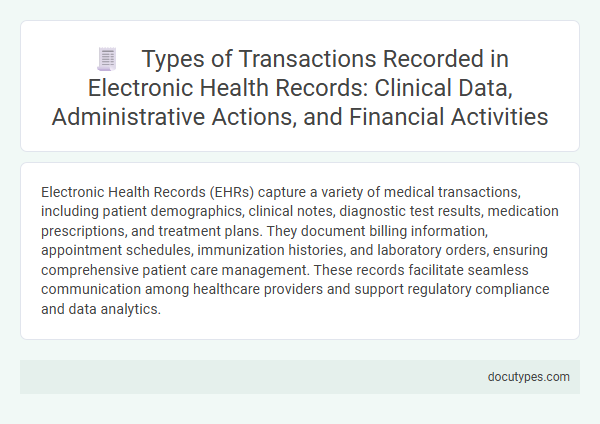Electronic Health Records (EHRs) capture a variety of medical transactions, including patient demographics, clinical notes, diagnostic test results, medication prescriptions, and treatment plans. They document billing information, appointment schedules, immunization histories, and laboratory orders, ensuring comprehensive patient care management. These records facilitate seamless communication among healthcare providers and support regulatory compliance and data analytics.
Overview of Electronic Health Record Transactions
Electronic Health Records (EHR) capture various types of transactions that document patient care and administrative activities. These transactions include clinical notes, medication orders, and diagnostic test results, ensuring a comprehensive health record.
Billing information, appointment schedules, and insurance claims are also recorded within EHR systems to support healthcare operations. This integration enhances data accuracy, streamlines workflows, and improves patient outcomes.
Classification of EHR Data Types
Electronic Health Records (EHR) document a wide range of medical transactions crucial for patient care. These transactions are classified into various data types, each serving a specific role in clinical management and healthcare delivery.
Structured data includes demographic information, vital signs, and medication lists, enabling efficient data retrieval and analysis. Unstructured data comprises clinical notes and narrative reports, providing detailed insights into patient history and physician observations.
Clinical Data Transactions in EHRs
Electronic Health Records (EHRs) primarily record clinical data transactions that document patient care activities. These transactions include the entry of vital signs, medication orders, lab test results, and progress notes from healthcare providers. Your clinical interactions, diagnostic imaging, and treatment plans are meticulously captured to ensure comprehensive and accessible medical histories.
Recording Patient Encounters and Medical History
Electronic Health Records (EHRs) document various types of transactions, primarily focusing on patient encounters and detailed medical history. These records capture essential clinical interactions to ensure accurate and comprehensive healthcare delivery.
Patient encounters include data such as consultation notes, diagnoses, treatments, and test results. Medical history encompasses past illnesses, surgeries, allergies, and family health background. You rely on these detailed records for effective and personalized medical care.
Medication and Laboratory Information Management
| Transaction Type | Description |
|---|---|
| Medication Orders | Electronic Health Records (EHR) capture detailed medication orders, including drug name, dosage, route of administration, frequency, and duration. This ensures accurate prescribing and administration. |
| Medication Dispensing | Records track medication dispensing events by pharmacy staff to monitor drug distribution, prevent errors, and support inventory control within clinical settings. |
| Medication Administration | Documentation of administered medications, including time, dose, and administering clinician, supports patient safety and adherence to treatment protocols. |
| Allergy and Adverse Drug Reactions | EHR systems log patient-reported allergies and any adverse reactions to medications, assisting in preventing harmful drug interactions. |
| Laboratory Test Orders | Test orders such as blood panels, microbiology cultures, and pathology analyses are recorded with test type, date/time, and ordering clinician details for streamlined sample processing. |
| Laboratory Results | Test results, including quantitative values, reference ranges, and interpretations, are integrated into patient records to support diagnosis and treatment planning. |
| Specimen Tracking | Information on sample collection, labeling, transportation, and processing status is logged to ensure specimen integrity and traceability. |
| Quality Control and Compliance | Laboratory-related transactions include records of quality control checks, equipment calibration, and adherence to regulatory standards for data accuracy and patient safety. |
Administrative Actions Captured in EHRs
Electronic Health Records (EHRs) capture a wide range of data related to patient care and healthcare facility operations. Among the most critical are administrative actions that ensure smooth management and accurate documentation.
- Patient Registration - Records demographic information, insurance details, and consent forms essential for patient identification and billing.
- Appointment Scheduling - Tracks appointment dates, times, cancellations, and rescheduling events to optimize clinical workflow.
- Insurance Verification - Documents verification of coverage and preauthorization status to facilitate claims processing.
Your healthcare provider relies on these administrative transactions within EHRs to maintain accurate records and improve service delivery.
Scheduling, Registration, and Documentation Processes
Electronic Health Records (EHRs) capture a wide range of transactions to improve patient care and streamline medical workflows. Your interactions with healthcare providers are meticulously documented to ensure accuracy and continuity of care.
- Scheduling Transactions - Records of appointment bookings, cancellations, and rescheduling to manage patient visits efficiently.
- Registration Processes - Entry and verification of patient demographics, insurance details, and consent forms during check-in.
- Documentation Processes - Detailed notes on clinical assessments, diagnoses, treatments, and progress from healthcare professionals.
Financial Activities and Billing Transactions
Electronic Health Records (EHR) capture a wide range of financial activities including billing transactions, insurance claims, and payment processing. These records ensure accurate documentation of charges for medical services rendered, facilitating streamlined billing and reimbursement. Your financial interactions with healthcare providers are securely recorded to maintain transparency and support efficient revenue cycle management.
Integration of Clinical, Administrative, and Financial Data
Electronic Health Records (EHRs) document a wide range of transactions essential for comprehensive patient care. These records integrate clinical, administrative, and financial data to enhance healthcare delivery and management.
- Clinical Data Transactions - This includes patient histories, diagnostic results, medication prescriptions, and treatment plans recorded during medical encounters.
- Administrative Data Transactions - Scheduling information, patient demographics, and consent forms are managed to streamline healthcare operations and communication.
- Financial Data Transactions - Billing records, insurance claims, and payment processing are incorporated to ensure accurate financial management and reimbursement.
What Types of Transactions Are Recorded in Electronic Health Records? Infographic

